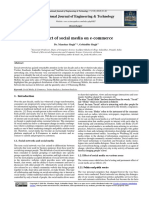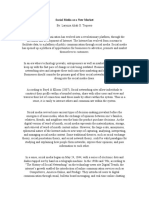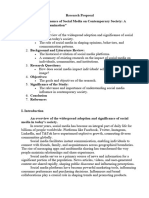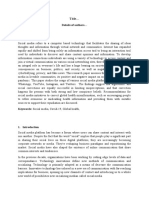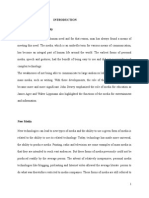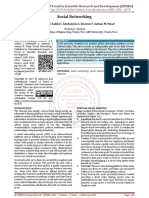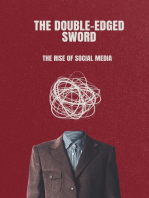0 ratings0% found this document useful (0 votes)
56 views(VL) Literature Review
(VL) Literature Review
Uploaded by
민윤지The literature review begins with an overview of social media, defining it as communications media that enable social interaction among users. Key characteristics of social media include participatory culture, where users generate and share content; mobile communication allowing instant interaction; and virality where content can spread rapidly. Social media facilitates two-way conversations and networking on digital platforms like Facebook, Twitter, and YouTube. It represents a shift from traditional one-way mass media to an interactive culture of user participation and collaboration.
Copyright:
© All Rights Reserved
Available Formats
Download as DOCX, PDF, TXT or read online from Scribd
(VL) Literature Review
(VL) Literature Review
Uploaded by
민윤지0 ratings0% found this document useful (0 votes)
56 views5 pagesThe literature review begins with an overview of social media, defining it as communications media that enable social interaction among users. Key characteristics of social media include participatory culture, where users generate and share content; mobile communication allowing instant interaction; and virality where content can spread rapidly. Social media facilitates two-way conversations and networking on digital platforms like Facebook, Twitter, and YouTube. It represents a shift from traditional one-way mass media to an interactive culture of user participation and collaboration.
Original Title
(VL) LITERATURE REVIEW
Copyright
© © All Rights Reserved
Available Formats
DOCX, PDF, TXT or read online from Scribd
Share this document
Did you find this document useful?
Is this content inappropriate?
The literature review begins with an overview of social media, defining it as communications media that enable social interaction among users. Key characteristics of social media include participatory culture, where users generate and share content; mobile communication allowing instant interaction; and virality where content can spread rapidly. Social media facilitates two-way conversations and networking on digital platforms like Facebook, Twitter, and YouTube. It represents a shift from traditional one-way mass media to an interactive culture of user participation and collaboration.
Copyright:
© All Rights Reserved
Available Formats
Download as DOCX, PDF, TXT or read online from Scribd
Download as docx, pdf, or txt
0 ratings0% found this document useful (0 votes)
56 views5 pages(VL) Literature Review
(VL) Literature Review
Uploaded by
민윤지The literature review begins with an overview of social media, defining it as communications media that enable social interaction among users. Key characteristics of social media include participatory culture, where users generate and share content; mobile communication allowing instant interaction; and virality where content can spread rapidly. Social media facilitates two-way conversations and networking on digital platforms like Facebook, Twitter, and YouTube. It represents a shift from traditional one-way mass media to an interactive culture of user participation and collaboration.
Copyright:
© All Rights Reserved
Available Formats
Download as DOCX, PDF, TXT or read online from Scribd
Download as docx, pdf, or txt
You are on page 1of 5
LITERATURE REVIEW
(pls rewrite it it sucks and gets like 90% turnitin)
1. Social media
Definition of social media
The Literature Review commences with the concept of social media, which is a term that
encompass the all-inclusive research.
In a 1994 article published in a Tokyo digital media platform called Matisse, the phrase "social
media" was first used (Bercovivi, 2010). According to Oxford Reference, social media is a broad
category or genre of communications medium that encourages or enables social contact among
groups of people, whether they are acquainted or not, gathered in one location or dispersed
geographically (Chandler & Munday, 2011). This new medium comprises MMOGs, social
networking sites, and newsgroups. These media may be symbolically perceived as online
gathering spaces which are intended to facilitate the sharing of media content among users who
are both creators and users.
In other words, social media refers to online platforms and technologies that allow users
generate, distribute, and engage with information as well as interact with others electronically.
Through numerous online channels, it enables people to maintain relationships with friends,
family, and even completely unrelated individuals. Users of social media platforms can exchange
messages, photos, videos, and other types of multimedia material, as well as engage in
synchronous or asynchronous conversations. Social media's primary characteristic is its
interactiveness, which enables users to have two-way conversations, voice their viewpoints, and
take part in discussions. By permitting people to establish personal profiles, communicate with
people who have comparable interests, join groups or communities, and follow or be followed by
other users, it fosters networking and community development.
In the era of broadcasting, the media is nearly fully concentrated when one organization, such
as a radio station, television station, press agency, or film studio, disseminates a message to a
large audience. Conventional media frequently elicits indirect, tardy, and impersonal responses.
Interpersonal communication frequently takes place on a much smaller scale, typically over the
phone or by personal mail, however it can also occasionally take place on a little larger scale
using tools such as duplicated family newsletters. (Manning, 2014)
Practically speaking, it is a group of software-based digital technologies that give users access to
digital environments where they may send and receive digital content or information across an
online social network. These technologies are typically displayed as applications and websites
(Gil Appel, 2020). Social media platforms frequently incorporate services that make it possible
for users to interact with material and one another, such as news feeds, notifications, likes,
comments, shares, and encrypted conversations. Facebook, Twitter, Instagram, LinkedIn,
Snapchat, and YouTube are a few examples of popular social media networks.
Characteristics of social media.
Social media networks are developing quickly, keeping up with the availability of faster-
changing technical tools. Whilst the characteristics may periodically alter, it is still feasible to
point out several distinctive traits of social networks, including the following three key concepts.
1. Participatory culture
It is crucial to consider the fundamental concept of participation in social media. The name
"social media" and the prefix "social" imply that these platforms facilitate social interactions.
The word "participatory" also emphasizes the importance of human cooperation (van Dijck,
2013)
The phrase "participatory culture" is frequently used to describe the participation of users,
audiences, customers, and fans in the production of culture and material. Examples include
collaboratively amending a Wikipedia page, posting photos or videos to YouTube, Flickr, or
Facebook, or writing brief remarks on Twitter or Weibo. The mass media and broadcasting
paradigm common to newspapers, radio, and television, where there is one sender and numerous
recipients, is sometimes opposed to the participatory culture approach (Fuchs, 2014)
Jenkins (2006) compares participatory culture with earlier concepts of passive media intake and
viewing. Media creators and consumers may be viewed as cooperating and engaging rather than
as playing distinct roles. Social media platforms frequently include collaboration features that let
users collaborate and co-create content. Users may cooperate on projects, participate in online
activities, or gather together to support a common cause, for instance. This collaborative quality
encourages collective intelligence and makes it possible for people with different viewpoints to
work together to meet shared objectives or obstacles.
2. Mobile communication
In order to facilitate quick interactions and conversations, social media platforms frequently
provide instant or almost instant communication channels, such as chat tools or direct messaging.
New websites are another characteristic of social media. Many of the most recent are geared
toward mobile communication and offer services to tablet and smartphone users. Technology's
dynamic and ever-evolving nature has contributed to social media's global popularity growth
(Lipschultz, 2018). The earliest cell phones supported voice communication. However
throughout the years, more features have been developed, such as integrated calendars, name
registers, and online games. In recent years, access to a wide range of internet information has
become a bigger part of this. Short messaging service, often known as texting, was one of the
first extra communication features.This feature enabled instantaneous text-based communication
by pressing messages to recipients (Ling, 2015). Communication boundaries are no longer an
obstacle because of this exceptional feature. One individual may communicate with numerous
others all over the world by sending hundreds of thousands of messages each day. In 2021, about
2 trillion SMS or MMS messages were exchanged by mobile phone users in the US alone.
Online communication that enables users to connect with one another in real-time without any
noticeable delays is known as real-time communication (RTC). Even over great geographic
distances, information is instantly sent between senders and receivers via RTC, without being
delayed or stored at any intermediary locations. (Bhattacharya, 2023) Individuals could make
judgments more quickly and in one motion thanks to real-time communication because there was
no waiting for peers to respond and no disruptions or delays. This led to better overall agility and
effective reaction management. Instant reaction through real-time communication may be very
useful for both professional and personal purposes in cases when time is of the matter, such as in
emergency response scenarios or time-sensitive business agreements.
3. Virality
Social media has the capacity to quickly spread material online. When a post receives a lot of
attention, it may be extensively shared and distributed, getting to a lot of users quickly. In fact,
virality has emerged as a crucial concept in a wide range of fields, including computer science,
marketing, communication studies, sociology, and information systems. The practice community
is aware that social media return on investment (ROI) is correlated with virality, whether through
corporate social media accounts or interactions with social influencers (V. Kumar, 2013).
Going viral is more frequently used to describe the spread of an object than information,
especially in the context of social media. Even if a fact, remark, joke, or other content can move
quickly over networks, it is more typical for a photo, video, sound bite, or website to accomplish
so. The goal of viral marketing is released into the environment and spreads and multiplies
without the help of its creator, almost precisely like a biological or computer virus (Mills, 2012).
However, things that become renowned too rapidly tend to go away swiftly, which helps to
explain in part why social networks are so much volatile and capricious. As can be seen, social
media is a dynamic field that constantly evolves. New platforms, features, and trends emerge
regularly, reflecting the changing needs and preferences of users.
Manning, J. (2014.) Social
media, definition and classes of.
In K. Harvey (Ed.),
Encyclopedia of social media
and politics (pp. 1158-1162).
Thousand Oaks, CA: Sage
Manning, J. (2014.) Social
media, definition and classes of.
In K. Harvey (Ed.),
Encyclopedia of social media
and politics (pp. 1158-1162).
Thousand Oaks, CA: Sage
Manning, J. (2014.) Social media, definition and classes of. In K. Harvey (Ed.), Encyclopedia of
social media and politics (pp. 1158-1162). Thousand Oaks, CA: Sage
Bercovici J. (2010) Who coined social media? Web pioneers compete for credit.
Forbes. http://forbes.com/sites/jeffbercovici/2010/12/09/who-coinedsocial-media-web-pioneers-
compete-for-credit/2/
2.
Aichner, T., Grünfelder, M., Maurer, O., & Jegeni, D. (2020). Twenty-Five Years of Social
Media: a Review of Social Media Applications and Definitions from 1994 to 2019.
Cyberpsychology, Behavior, and Social Networking, 24(4), 215–222.
https://doi.org/10.1089/cyber.2020.0134
Appel, G., Grewal, L., Hadi, R., & Stephen, A. T. (2019). The Future of Social Media in
Marketing. Journal of the Academy of Marketing Science, 48(1), 79–95. Springer.
https://doi.org/10.1007/s11747-019-00695-1
Fuchs, C. (2014). Social Media as Participatory Culture. Social Media: A Critical Introduction,
52–68. https://doi.org/10.4135/9781446270066.n3
van Dijck, J. (2009). Users like you? Theorizing agency in user-generated content. Media,
Culture & Society, 31(1), 41–58. https://doi.org/10.1177/0163443708098245
Jenkins, H. (2006). Convergence Culture: Where Old and New Media Collide. New York: New
York University Press
You might also like
- Impact of Social Media On E-CommerceDocument6 pagesImpact of Social Media On E-CommerceGo Career100% (1)
- QUOTES On WEB 2.ODocument14 pagesQUOTES On WEB 2.Ojacob_robinNo ratings yet
- Chapter Two For JunaidDocument23 pagesChapter Two For JunaidoluwaseunNo ratings yet
- GROUP ONE (1) NM & CT PRESENTATION - UpdatedDocument18 pagesGROUP ONE (1) NM & CT PRESENTATION - Updatedayornu thomasNo ratings yet
- Impact of Social MediaDocument8 pagesImpact of Social MediashajiahNo ratings yet
- Social Media ... Chapter 1Document50 pagesSocial Media ... Chapter 1ANJALI JAMESNo ratings yet
- Socialand Traditional Mainstream Mediaof CommunicationDocument5 pagesSocialand Traditional Mainstream Mediaof Communicationপ্রিয়ংবদা মিতাNo ratings yet
- Web 2.0 Internet User-Generated Content Digital Photos App Organization Social NetworksDocument3 pagesWeb 2.0 Internet User-Generated Content Digital Photos App Organization Social NetworksKatthi LoguNo ratings yet
- Social MediaDocument19 pagesSocial MediaareejramadistinctNo ratings yet
- Discourse and Social Media. 11Document9 pagesDiscourse and Social Media. 11alex bieberNo ratings yet
- A Term PaperDocument7 pagesA Term PapertemoleadsNo ratings yet
- PR&DC5Document26 pagesPR&DC5nali.376926No ratings yet
- Social Media As A New MarketDocument4 pagesSocial Media As A New MarketLaryzza Aliah ToqueroNo ratings yet
- Research Proposal KalanchaDocument10 pagesResearch Proposal KalanchaAna-Maria CalanceaNo ratings yet
- Wurood Shaher. Synopsis Social Media History AssignmentDocument5 pagesWurood Shaher. Synopsis Social Media History AssignmentWurood ShaherNo ratings yet
- Analyzing The Effects of Social Media On The Hospitality IndustryDocument21 pagesAnalyzing The Effects of Social Media On The Hospitality IndustryHa Le HiepNo ratings yet
- Technology-Mediated Social ParticipationDocument20 pagesTechnology-Mediated Social ParticipationLiberto CarratalaNo ratings yet
- The Development and Influence of Social MediaDocument4 pagesThe Development and Influence of Social MediaMahmudul Hasan Ankon ChowdhuryNo ratings yet
- GSSUzu Uzo 1Document17 pagesGSSUzu Uzo 1Melinda AprilyaNo ratings yet
- Power of Digitization in Mass MediaDocument5 pagesPower of Digitization in Mass Mediamiki pikiNo ratings yet
- Chapter One Onome 2Document19 pagesChapter One Onome 2clementjosh224No ratings yet
- Fma1 Mms102 TrinidadDocument3 pagesFma1 Mms102 TrinidadHenry TrinidadNo ratings yet
- Social Network As Marketing ToolsDocument12 pagesSocial Network As Marketing Toolsepo_tianNo ratings yet
- Research Managing Diversity AfifyDocument26 pagesResearch Managing Diversity AfifyAhmed Youssri TeleebaNo ratings yet
- What IS Social MediaDocument9 pagesWhat IS Social MediaShahzad SaifNo ratings yet
- The Influence of Social Media On Economic Growth in The Society ProjectDocument58 pagesThe Influence of Social Media On Economic Growth in The Society ProjectBatifeNo ratings yet
- Socijalne MedijeDocument2 pagesSocijalne MedijeBoban LempicNo ratings yet
- Social MediaDocument11 pagesSocial MediaNoel MKNo ratings yet
- Social Media and Social Media Marketing: A Literature ReviewDocument4 pagesSocial Media and Social Media Marketing: A Literature ReviewIOSRjournalNo ratings yet
- Social Media EssayDocument5 pagesSocial Media Essayritek42609No ratings yet
- The Development of A Conceptual Framework of Social Media LiteracyDocument18 pagesThe Development of A Conceptual Framework of Social Media LiteracyJahnRey BaltarNo ratings yet
- Influence of Social Media On The Interpersonal Communication Skills of Senior High School Students at Cotabato City InstituteDocument12 pagesInfluence of Social Media On The Interpersonal Communication Skills of Senior High School Students at Cotabato City InstituteRolly DiamondNo ratings yet
- Lesson 3 Living in The It EraDocument34 pagesLesson 3 Living in The It EraEzra JungNo ratings yet
- Chapter One 1.1 Background To StudyDocument94 pagesChapter One 1.1 Background To StudyTony Omorotionmwan AirhiavbereNo ratings yet
- SSRN Id3395665 PDFDocument8 pagesSSRN Id3395665 PDFAsif imtiaz islamNo ratings yet
- IOSR Journal of Business and ManagementDocument7 pagesIOSR Journal of Business and Managementcreo.loyy19No ratings yet
- The Influence of Social Media On Buy Decision-MakiDocument5 pagesThe Influence of Social Media On Buy Decision-MakiTrương Quang TườngNo ratings yet
- Social NetworkingDocument3 pagesSocial NetworkingEditor IJTSRDNo ratings yet
- Persuasive Communication in Social MediaDocument9 pagesPersuasive Communication in Social MediaAnshul GuptaNo ratings yet
- Reviewer FOR MEDIADocument4 pagesReviewer FOR MEDIAClaes TrinioNo ratings yet
- Mohd - Sarwar AlamDocument12 pagesMohd - Sarwar AlamMahanand JoshiNo ratings yet
- Virtual CommunityDocument14 pagesVirtual CommunityLi Zi LuoNo ratings yet
- Social Media Family Personal Relations PDFDocument12 pagesSocial Media Family Personal Relations PDFSoma BhowmickNo ratings yet
- Media LiteracyDocument9 pagesMedia LiteracyNathan RodriguezNo ratings yet
- What Is Interactive Media1Document4 pagesWhat Is Interactive Media1Jerry IntongNo ratings yet
- (Research Paper) - Brands Learning Their Meme ABC - Nieuwenhuis, Rasmey & LeDocument18 pages(Research Paper) - Brands Learning Their Meme ABC - Nieuwenhuis, Rasmey & LeRasmey HeangNo ratings yet
- DC 204 Report Best PracticesDocument2 pagesDC 204 Report Best Practicesanniedump28No ratings yet
- Social Media WikiDocument1 pageSocial Media WikiHaru ZenkonsteinNo ratings yet
- Share Like Recommend Decoding The SocialDocument10 pagesShare Like Recommend Decoding The SocialNatalia Raimondo AnselminoNo ratings yet
- Assignment Final DrafDocument14 pagesAssignment Final DrafKasturi KSNo ratings yet
- Original Mass CommDocument35 pagesOriginal Mass CommStephen NarteyNo ratings yet
- Nitesh File - 2-9-66Document58 pagesNitesh File - 2-9-66tarunNo ratings yet
- Research PaperDocument10 pagesResearch PaperRochak AdhikariNo ratings yet
- Analyzing The Effects of Social Media On The Hospitality IndustryDocument21 pagesAnalyzing The Effects of Social Media On The Hospitality IndustryTaniya WickramaratneNo ratings yet
- Social Media WikipediaDocument13 pagesSocial Media Wikipediaabxy7No ratings yet
- Social Media, Society and Law - Contemporary Issues and ChallengesDocument6 pagesSocial Media, Society and Law - Contemporary Issues and ChallengesAnonymous CwJeBCAXpNo ratings yet
- Social MediaDocument9 pagesSocial Mediapradhanniranjan345No ratings yet
- Paradigms of CommunicationDocument6 pagesParadigms of CommunicationCatleen MadayagNo ratings yet
- Top 30 OOPS Interview Questions and AnswersDocument10 pagesTop 30 OOPS Interview Questions and Answersvjay2003No ratings yet
- Manufacturing and Schedule Planning Via Black Widow Optimization AlgorithmDocument11 pagesManufacturing and Schedule Planning Via Black Widow Optimization AlgorithmTJPRC PublicationsNo ratings yet
- Discovering Bryce 5 TerrainsDocument7 pagesDiscovering Bryce 5 TerrainsMarcos Germano DegenhardtNo ratings yet
- CS305 Chapter Summary 1Document4 pagesCS305 Chapter Summary 1rehanandhikaNo ratings yet
- Oracle E-Business Suite Installation Guide E22950Document166 pagesOracle E-Business Suite Installation Guide E22950support ofoqsolutionsNo ratings yet
- Motion Detection Application Using Web CameraDocument3 pagesMotion Detection Application Using Web CameraIlham ClinkersNo ratings yet
- Modem StandardsDocument28 pagesModem StandardsShammer ShaNo ratings yet
- New Resume-Converted+ (1) +Document2 pagesNew Resume-Converted+ (1) +TED HRNo ratings yet
- Tellabs - 8813-311v Ethernet Access NodeDocument3 pagesTellabs - 8813-311v Ethernet Access NodeNithindev GuttikondaNo ratings yet
- Antology Uniy8Document12 pagesAntology Uniy8esmeralda mendozaNo ratings yet
- ExcelAnalytics SalesAnalysisofBusinessSegments TemplateDocument16 pagesExcelAnalytics SalesAnalysisofBusinessSegments TemplateTess CoaryNo ratings yet
- ABB Product BrochureDocument27 pagesABB Product BrochureAl RANo ratings yet
- Im15 en 20230814Document2 pagesIm15 en 20230814jason.nganNo ratings yet
- Enhancing Security of Data in Cloud Storage Using Decentralized Block ChainDocument4 pagesEnhancing Security of Data in Cloud Storage Using Decentralized Block ChainDipak AryalNo ratings yet
- Rubix MLDocument4 pagesRubix MLcoderzdev14No ratings yet
- Combiac0 & Ace0: User ManualDocument77 pagesCombiac0 & Ace0: User Manualbista chaymaNo ratings yet
- HTMLDocument115 pagesHTMLBoppana yaswanthNo ratings yet
- Call Booking Script 1Document3 pagesCall Booking Script 1IlongNo ratings yet
- CSC263 Image 2Document3 pagesCSC263 Image 2ijijijiNo ratings yet
- Assignment 3-Group Project CNG1024X03 Networking IDocument15 pagesAssignment 3-Group Project CNG1024X03 Networking Ichris.browNo ratings yet
- Accounting Info and Financial PerformanceDocument61 pagesAccounting Info and Financial PerformancevitalisNo ratings yet
- Yvee System DocumentationDocument47 pagesYvee System DocumentationYvettee NdlovuNo ratings yet
- Unit 4: Descriptive StatisticsDocument59 pagesUnit 4: Descriptive StatisticsJanet GabrielNo ratings yet
- Analytics: Adding Value To Big DataDocument24 pagesAnalytics: Adding Value To Big DataFido FidoNo ratings yet
- BCS2A Reviewer PrelimsDocument15 pagesBCS2A Reviewer PrelimsAndrea Angelica Dumo GalvezNo ratings yet
- Basic Interview Questions On OOPSDocument22 pagesBasic Interview Questions On OOPSThirumal AnandNo ratings yet
- Serial-No. Brand Model Screen Size Screen Type Screen ResolutionDocument6 pagesSerial-No. Brand Model Screen Size Screen Type Screen ResolutionComsa MariusNo ratings yet
- DMDW 3Document2 pagesDMDW 3raju rama raj kumarNo ratings yet
- EPLC Interface Control ChecklistDocument2 pagesEPLC Interface Control ChecklistHimanshuGaurNo ratings yet
- Point of Care Smartphone Based ElectrochemicalBiosensingDocument15 pagesPoint of Care Smartphone Based ElectrochemicalBiosensingJoão CostaNo ratings yet
